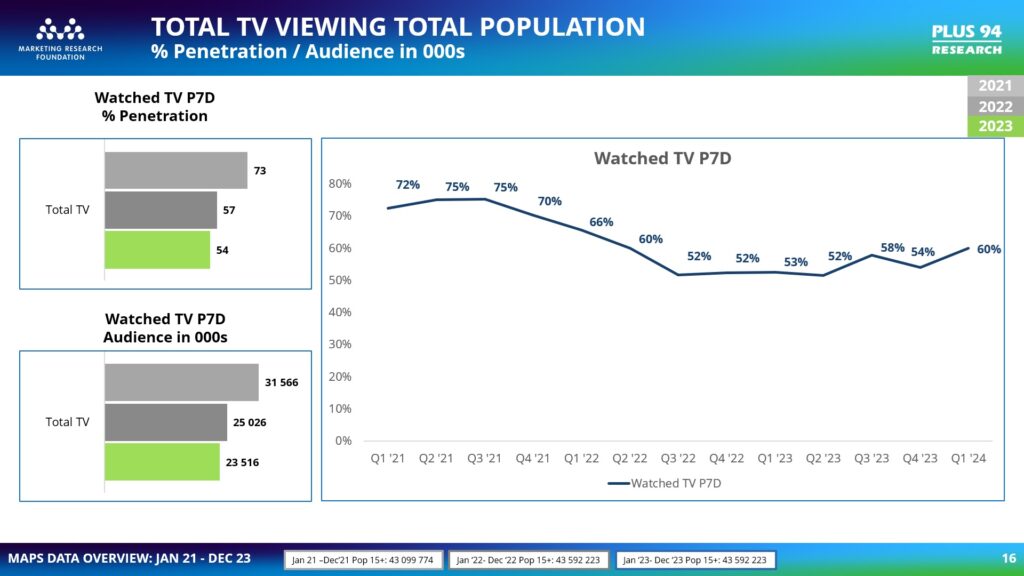
By Isla Prentis, Intelligence Lead at human insights agency Tirisano Consulting, a company within The MediaShop stable.
 It’s that time of the year (again) for us to dive through a mountain of data to comprehend how the overall media landscape has evolved. We explore a multitude of topics to understand the changes and the impact on our industry. Let’s very briefly discuss what we learnt this year.
It’s that time of the year (again) for us to dive through a mountain of data to comprehend how the overall media landscape has evolved. We explore a multitude of topics to understand the changes and the impact on our industry. Let’s very briefly discuss what we learnt this year.
The advertising industry has shown a strong recovery both in South Africa and globally. However, exposure exceeds spend recovery as value becomes the driver of all spend decisions. When it comes to value, we need to remember that the definition is so broad it can mean different things to different people.
With this in mind, we need to make sure that we are having constant conversations about a shared meaning of value in whichever context you are in. This is crucial so that we can ensure that we are growing true value and not merely a rate card value without meaning. We also need to remember that whilst we’re seeing a strong recovery, we need to be aware that the consumer and economy remain under pressure. We are living in a volatile time and growth could change at any given time.
From an audience perspective, the current media pond is under threat – big threat. For years the industry was a relatively calm pond with slow steady changes. For the past few years, however, we have seen a rapid increase of the pace of change, and we believe that it’s about to get faster. There are three major topics that are causing major disruption now. We like to see these as pebbles, stones, boulders (we’ll let you decide) that are causing rather large ripples in the calm pond.
Content creation – everyone who wants to create content has access to very large, and growing, audiences. The continued rise of social media reminds us that everyone who wants to have a voice is going out and making sure they get heard.
This time last year, I didn’t believe it would happen, but Digital Terrestrial Television (DTT) has started and it’s disrupting already threatened television audiences. We need to constantly learn and adapt as this audience fluctuates. We no longer have the homogenous TV viewership market that we did a few years ago.
Lastly, the line between digital and traditional media continues to blur and we need to understand the easy transition between these. Similarly, life in the physical world blurs with the virtual world with the rise of social media, gaming and the Metaverse. It’s in this reality that we need to plan for – simultaneously across online and offline platforms as the consumer moves so easily between different formats.
Each of these stones have been accelerated by and grown by life in a pandemic but are mostly still impacted by the cost of data in South Africa – a pressure point that may become a non-factor in the not-too-distant future. The result of these ripples – fragmentation – increasing the difficulty and cost of reaching audiences.
With so many, sometimes outdated, and varied data research resources available in the industry, we know that it’s more critical than ever to focus beyond the data collection conversation. We need to overcome the silos and fragmentation of research spend as an industry but in the meantime, we can embrace the role of automation in processing information. When we shift the conversation to this, we need to remind ourselves that human application is critical to move to a point of insight. We spend too much time focusing on what data we have rather than focusing on what the data truly means. This is all critical to understand the consumer and their behaviour, and it is only with understanding and those insights into the data that we can create relevance for the consumer.
Lastly, we explored how consumer behaviour is changing while emerging from a pandemic. We all adapted instantly to life in a pandemic and now we’re all reacting to the end of the pandemic. In a disruptive period as consumer behaviour becomes incredibly divergent. Different people choosing different behaviours makes it even more challenging for a brand to connect with an audience. We don’t expect behaviour to converge anytime soon – so we need to remain in an adaptive state. As consumer behaviour changes, we need to understand what behaviour we can influence, but also understand what changing behaviour we can leverage.
Overall, we’re living in a state of flux. So as Glenda Cloud said “Change is inevitable. Growth is intentional”.
- The BRC announces changes to the board and updates for 2025 - 17th December 2024
- Top 50 DSTV TV programmes – October 2024 - 12th November 2024
- Top 50 FTA TV programmes – October 2024 - 12th November 2024




